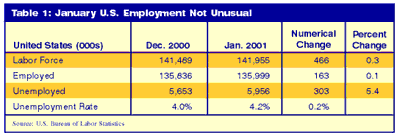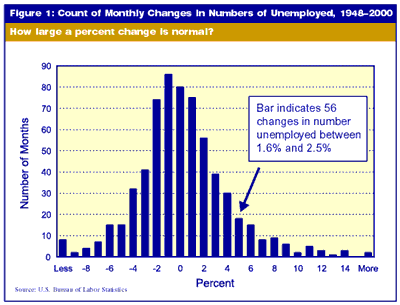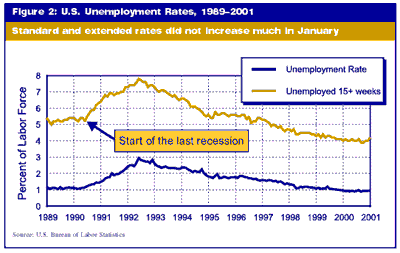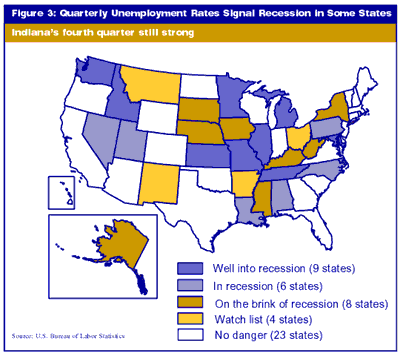No Recession in National Unemployment Data
Unemployment is a serious matter. But the data gathered for determining labor market conditions do not always have the financial resources from Congress that they need to give the clearest possible picture of the nation's economy. Often we must wait until more data are gathered before drawing any conclusions from the information at hand.
A good example of this problem occurred with the release of the January 2001 data from the U.S. Bureau of Labor Statistics. Amid great concern about the state of the U.S. economy, these data were jumped on as "evidence" of a recession-in-the-making. Let's look at the data in Table 1.

From December 2000 to January 2001, the number of unemployed people in the nation rose by 303,000, or 5.4% (see Table 1). This is an impressive jump - until it is seen in perspective.
Since the beginning of 1948, we have 636 monthly observations of the change in the number unemployed. Of these monthly changes, 10.4% were either greater than 300,000 or less than -300,000. Therefore, on average, we can expect a change of 300,000 or more in the number of people unemployed once every 10 months. This suggests that such changes are not extraordinary.
Next let's look at the 5.4% increase in the number unemployed. The distribution of such percentage changes is shown in Figure 1. More than 80 times, the change in the number unemployed was between -1.6% and -0.5%. There were 18 observations in this series that fell between 4.6% and 5.5%. Again, this is not an extraordinary event.

The mean value of this series of changes is 0.25% with a standard deviation of 4.15%. Thus, the 5.4% change observed in January 2001 was 1.3 times the standard deviation and well within the range of values historically observed in this series. In short, a change of 303,000 (an increase of 5.4%) in the number unemployed is not itself a statistically disturbing finding.
A recession in the making?
There is no question that an increase of 303,000 reflects real hardship for those who lost their jobs. But is it the start of a recession? That answer must await more information. Yet while U.S. unemployment was increasing in January 2001, 163,000 more people reported that they were employed than in the previous month. That marks the sixth consecutive month of employment gains, a total of 1,101,000 more people at work than in July 2000.
In January 2001, the total unemployment rate rose to 4.2% of the labor force from 4.0% in December. At the start of the last recession - July 1990 - the unemployment rate rose to 5.5% from 5.2% and proceeded to increase to 7.8% in June 1992 (see Figure 2).

As is characteristic of a recession, not only did the total unemployment rate rise, but the percent of the labor force unemployed 15 weeks or more also rose in this period. But in the current period, there is no evidence that this long-term unemployment rate is rising.
Although there is much uncertainty about the economy at this time, the evidence is not present in the unemployment rate to declare that a recession is upon us.
States in recession?
Although no national recession is evident, there may be unemployment recessions in a number of states (see Figure 3). Fifteen states and the District of Columbia had two or more consecutive quarters of rising unemployment rates. Nine of these 15, including Illinois, Michigan and Tennessee, experienced rising unemployment rates for at least three quarters in a row.
Click on map to see larger version.

On the brink of an unemployment recession are eight states, including Kentucky. These states had rising unemployment rates in the most recent quarter and could tip into a recession in the first three months of 2001.
At the same time, four states (Arkansas, Montana, New Mexico and Ohio) are on the watch list. While their percentage unemployment rate did not increase in the fourth quarter, they show other signs of weakening labor markets. The remaining 23 states, including Indiana, Wisconsin, Florida and California, had no increase in unemployment rates in the most recent quarter (2000:4) and reported other labor-market indicators at varying but not yet worrisome levels
